Abstract
Chediak-Higashi syndrome (CHS) is an autosomal recessive disorder characterized by hypopigmentation or oculocutaneous albinism and severe immunologic deficiency with neutropenia and lack of natural killer (NK) cell function. Most patients die in childhood from pyogenic infections or an unusual lymphoma-like condition. A hallmark of the disorder is giant inclusion bodies seen in all granule-containing cells, including granulocytes, lymphocytes, melanocytes, mast cells, and neurons. Similar ultrastructural abnormalities occur in the beige mouse, which thus has been suggested to be homologous to human CHS. High-resolution genetic mapping has indicated that the bg gene region of mouse chromosome 13 is likely homologous to the distal portion of human chromosome 1q. Accordingly, we carried out homozygosity mapping using markers derived from distal human chromosome 1q in four inbred families or probands with CHS. Our results indicate that the human CHS gene maps to an 18.8-cM interval in chromosome segment 1q42-q44 and that human CHS therefore is very likely homologous to mouse bg.
Full text
PDF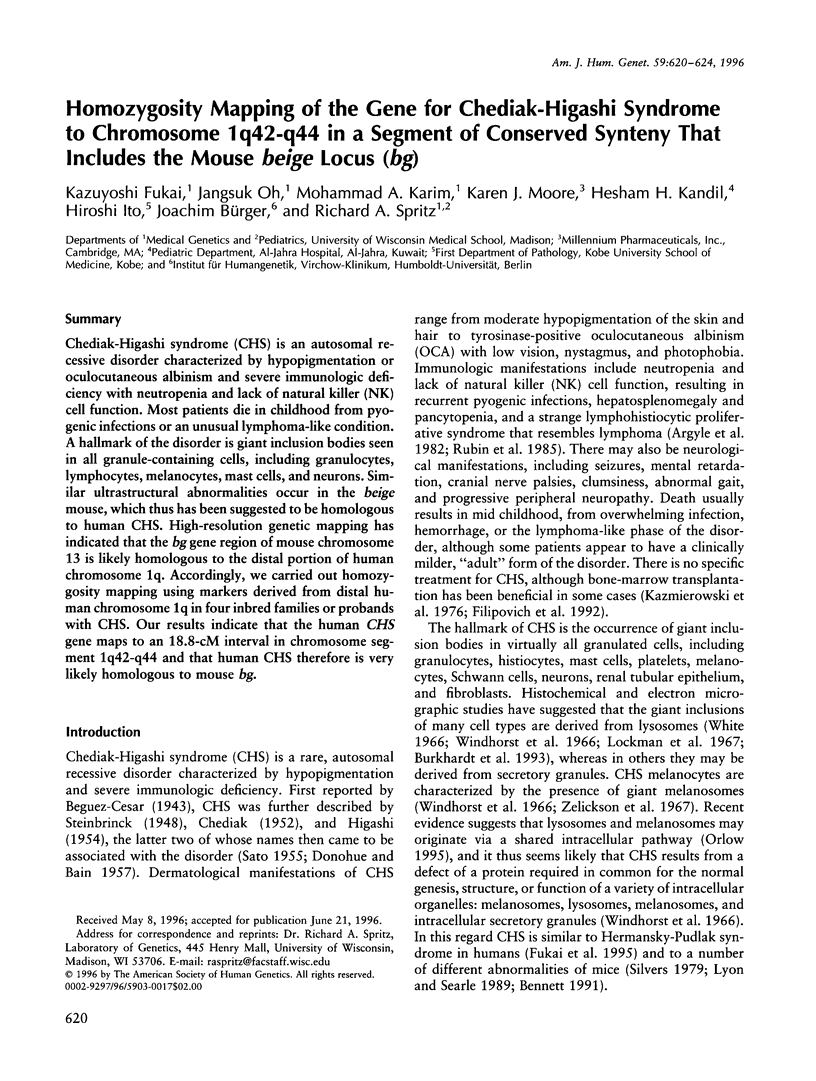
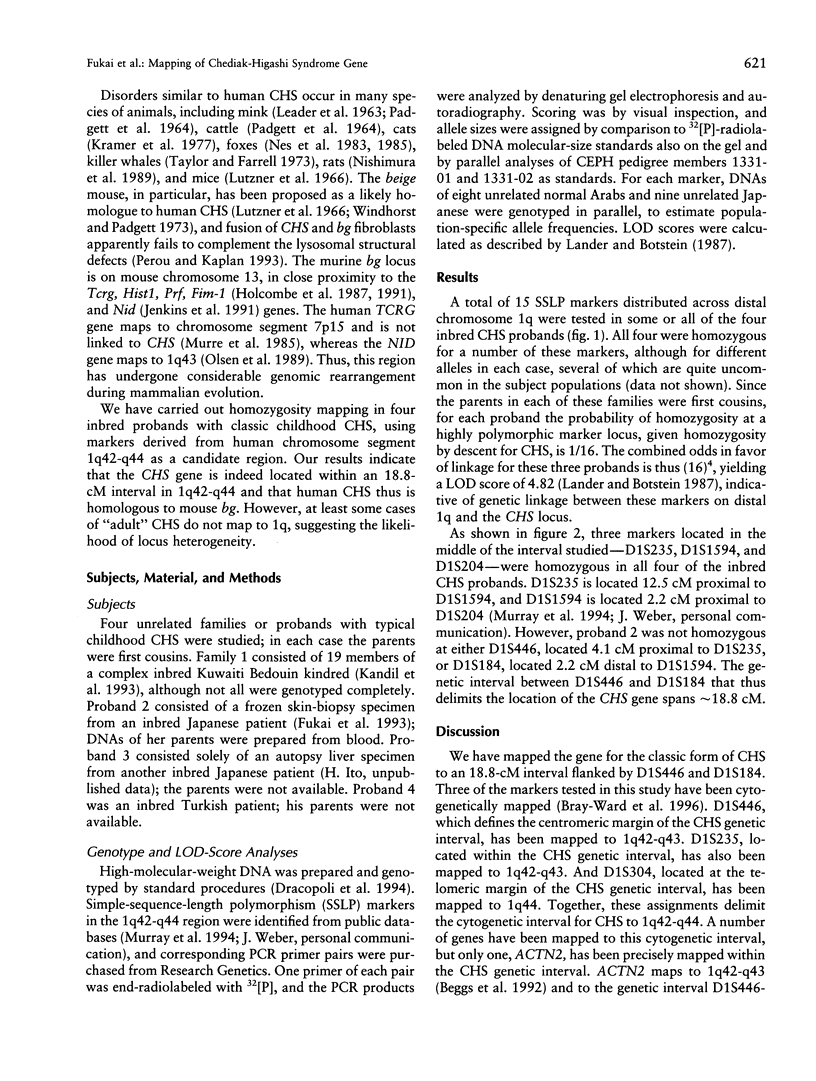
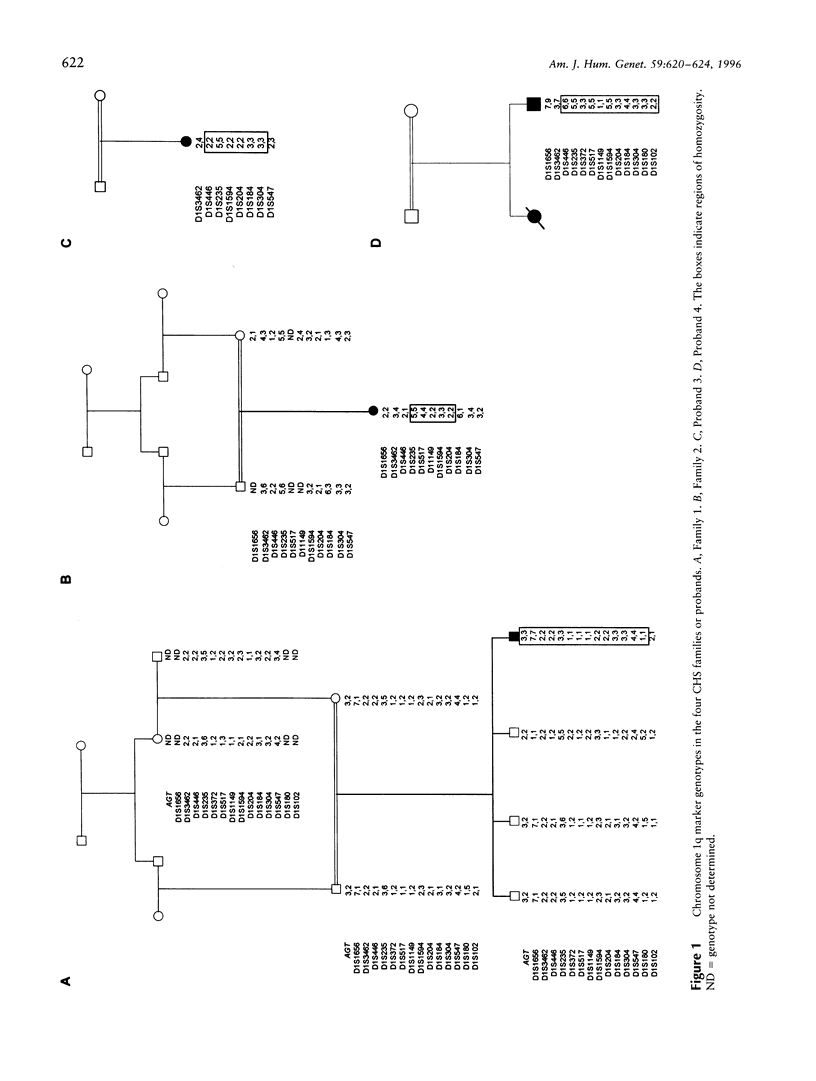
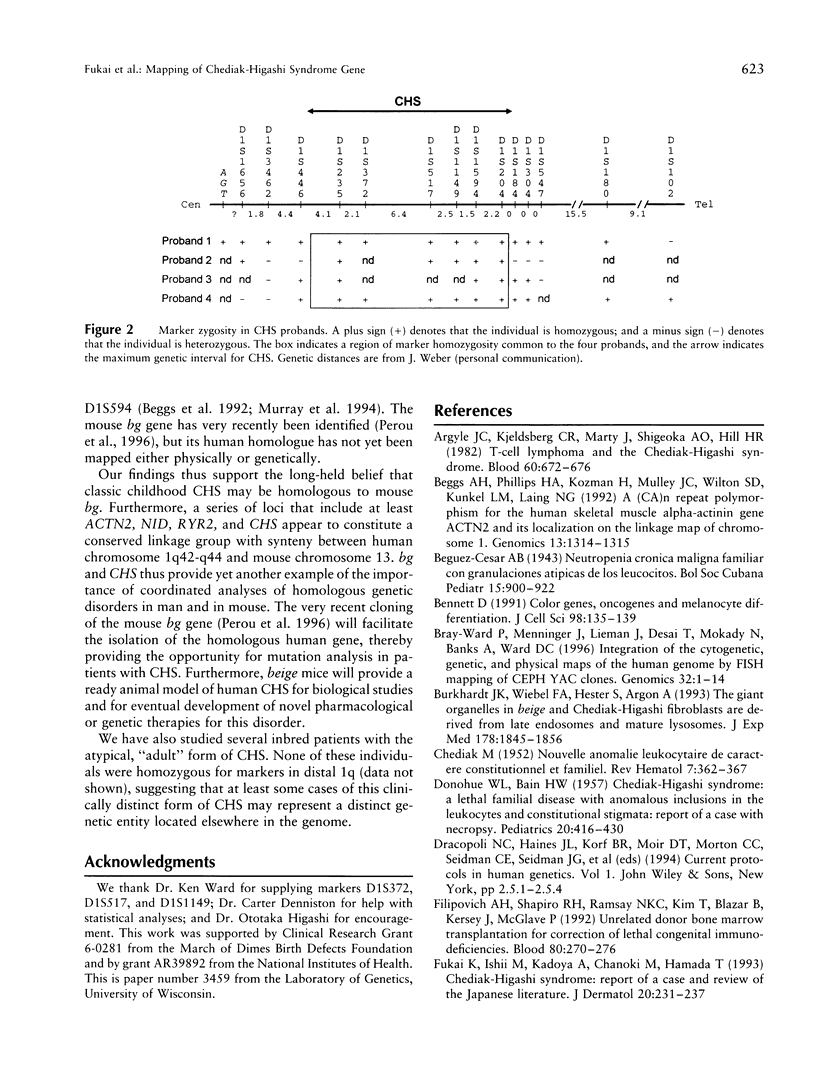
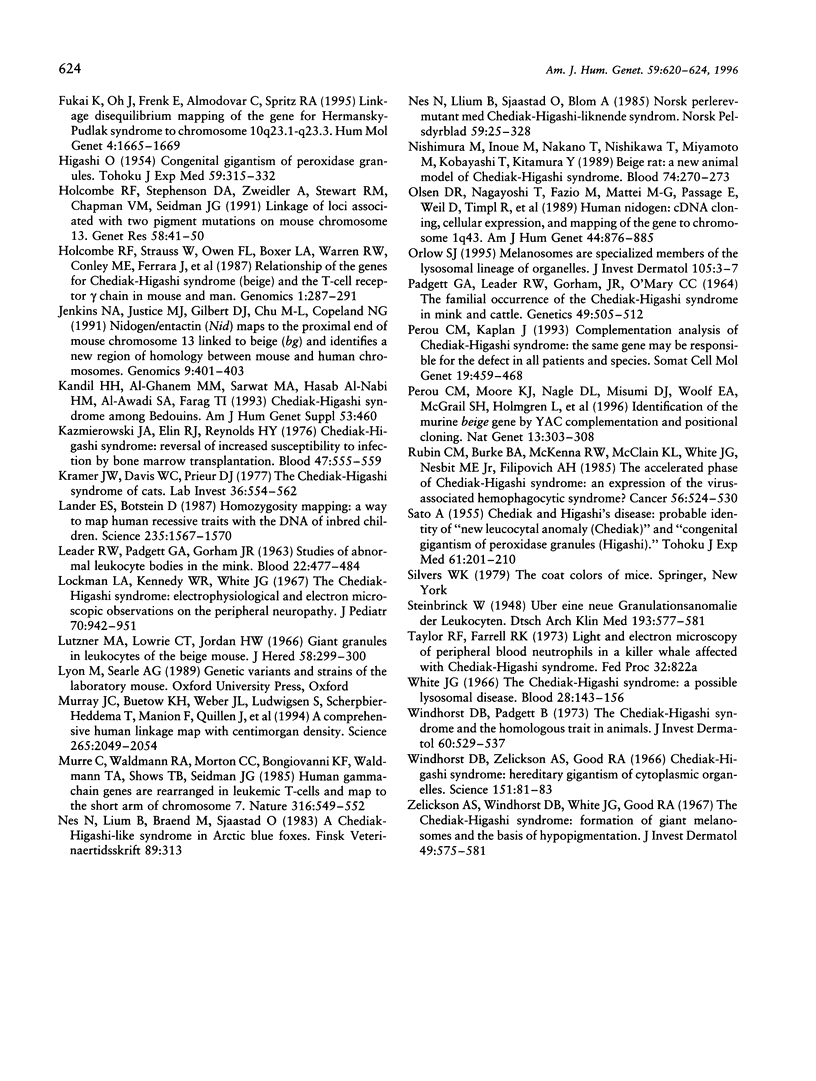
Selected References
These references are in PubMed. This may not be the complete list of references from this article.
- Argyle J. C., Kjeldsberg C. R., Marty J., Shigeoka A. O., Hill H. R. T-cell lymphoma and the Chediak-Higashi syndrome. Blood. 1982 Sep;60(3):672–676. [PubMed] [Google Scholar]
- Beggs A. H., Phillips H. A., Kozman H., Mulley J. C., Wilton S. D., Kunkel L. M., Laing N. G. A (CA)n repeat polymorphism for the human skeletal muscle alpha-actinin gene ACTN2 and its localization on the linkage map of chromosome 1. Genomics. 1992 Aug;13(4):1314–1315. doi: 10.1016/0888-7543(92)90054-v. [DOI] [PubMed] [Google Scholar]
- Bennett D. C. Colour genes, oncogenes and melanocyte differentiation. J Cell Sci. 1991 Feb;98(Pt 2):135–139. doi: 10.1242/jcs.98.2.135. [DOI] [PubMed] [Google Scholar]
- Bray-Ward P., Menninger J., Lieman J., Desai T., Mokady N., Banks A., Ward D. C. Integration of the cytogenetic, genetic, and physical maps of the human genome by FISH mapping of CEPH YAC clones. Genomics. 1996 Feb 15;32(1):1–14. doi: 10.1006/geno.1996.0070. [DOI] [PubMed] [Google Scholar]
- Burkhardt J. K., Wiebel F. A., Hester S., Argon Y. The giant organelles in beige and Chediak-Higashi fibroblasts are derived from late endosomes and mature lysosomes. J Exp Med. 1993 Dec 1;178(6):1845–1856. doi: 10.1084/jem.178.6.1845. [DOI] [PMC free article] [PubMed] [Google Scholar]
- CHEDIAK M. M. Nouvelle anomalie leucocytaire de caractère constitutionnel et familial. Rev Hematol. 1952;7(3):362–367. [PubMed] [Google Scholar]
- DONOHUE W. L., BAIN H. W. Chédiak-Higashi syndrome; a lethal familial disease with anomalous inclusions in the leukocytes and constitutional stigmata: report of a case with necropsy. Pediatrics. 1957 Sep;20(3):416–430. [PubMed] [Google Scholar]
- Filipovich A. H., Shapiro R. S., Ramsay N. K., Kim T., Blazar B., Kersey J., McGlave P. Unrelated donor bone marrow transplantation for correction of lethal congenital immunodeficiencies. Blood. 1992 Jul 1;80(1):270–276. [PubMed] [Google Scholar]
- Fukai K., Ishii M., Kadoya A., Chanoki M., Hamada T. Chédiak-Higashi syndrome: report of a case and review of the Japanese literature. J Dermatol. 1993 Apr;20(4):231–237. doi: 10.1111/j.1346-8138.1993.tb03867.x. [DOI] [PubMed] [Google Scholar]
- Fukai K., Oh J., Frenk E., Almodóvar C., Spritz R. A. Linkage disequilibrium mapping of the gene for Hermansky-Pudlak syndrome to chromosome 10q23.1-q23.3. Hum Mol Genet. 1995 Sep;4(9):1665–1669. doi: 10.1093/hmg/4.9.1665. [DOI] [PubMed] [Google Scholar]
- HIGASHI O. Congenital gigantism of peroxidase granules; the first case ever reported of qualitative abnormity of peroxidase. Tohoku J Exp Med. 1954 Feb 25;59(3):315–332. doi: 10.1620/tjem.59.315. [DOI] [PubMed] [Google Scholar]
- Holcombe R. F., Stephenson D. A., Zweidler A., Stewart R. M., Chapman V. M., Seidman J. G. Linkage of loci associated with two pigment mutations on mouse chromosome 13. Genet Res. 1991 Aug;58(1):41–50. doi: 10.1017/s0016672300029591. [DOI] [PubMed] [Google Scholar]
- Holcombe R. F., Strauss W., Owen F. L., Boxer L. A., Warren R. W., Conley M. E., Ferrara J., Leavitt R. Y., Fauci A. S., Taylor B. A. Relationship of the genes for Chediak-Higashi syndrome (beige) and the T-cell receptor gamma chain in mouse and man. Genomics. 1987 Nov;1(3):287–291. doi: 10.1016/0888-7543(87)90058-9. [DOI] [PubMed] [Google Scholar]
- Jenkins N. A., Justice M. J., Gilbert D. J., Chu M. L., Copeland N. G. Nidogen/entactin (Nid) maps to the proximal end of mouse chromosome 13 linked to beige (bg) and identifies a new region of homology between mouse and human chromosomes. Genomics. 1991 Feb;9(2):401–403. doi: 10.1016/0888-7543(91)90275-j. [DOI] [PubMed] [Google Scholar]
- Kazmierowski J. A., Elin R. J., Reynolds H. Y., Durbin W. A., Wolff S. M. Chediak-Higashi syndrome: reversal of increased susceptibility to infection by bone marrow transplantation. Blood. 1976 Apr;47(4):555–559. [PubMed] [Google Scholar]
- Kramer J. W., Davis W. C., Prieur D. J. The Chediak-Higashi syndrome of cats. Lab Invest. 1977 May;36(5):554–562. [PubMed] [Google Scholar]
- LEADER R. W., PADGETT G. A., GORHAM J. R. STUDIES OF ABNORMAL LEUKOCYTE BODIES IN THE MINK. Blood. 1963 Oct;22:477–484. [PubMed] [Google Scholar]
- Lander E. S., Botstein D. Homozygosity mapping: a way to map human recessive traits with the DNA of inbred children. Science. 1987 Jun 19;236(4808):1567–1570. doi: 10.1126/science.2884728. [DOI] [PubMed] [Google Scholar]
- Lockman L. A., Kennedy W. R., White J. G. The Chediak-Higashi syndrome: electrophysiological and electron microscopic observations on the peripheral neuropathy. J Pediatr. 1967 Jun;70(6):942–951. doi: 10.1016/s0022-3476(67)80267-1. [DOI] [PubMed] [Google Scholar]
- Lutzner M. A., Lowrie C. T., Jordan H. W. Giant granules in leukocytes of the beige mouse. J Hered. 1967 Nov-Dec;58(6):299–300. doi: 10.1093/oxfordjournals.jhered.a107620. [DOI] [PubMed] [Google Scholar]
- Murray J. C., Buetow K. H., Weber J. L., Ludwigsen S., Scherpbier-Heddema T., Manion F., Quillen J., Sheffield V. C., Sunden S., Duyk G. M. A comprehensive human linkage map with centimorgan density. Cooperative Human Linkage Center (CHLC). Science. 1994 Sep 30;265(5181):2049–2054. doi: 10.1126/science.8091227. [DOI] [PubMed] [Google Scholar]
- Murre C., Waldmann R. A., Morton C. C., Bongiovanni K. F., Waldmann T. A., Shows T. B., Seidman J. G. Human gamma-chain genes are rearranged in leukaemic T cells and map to the short arm of chromosome 7. Nature. 1985 Aug 8;316(6028):549–552. doi: 10.1038/316549a0. [DOI] [PubMed] [Google Scholar]
- Nishimura M., Inoue M., Nakano T., Nishikawa T., Miyamoto M., Kobayashi T., Kitamura Y. Beige rat: a new animal model of Chediak-Higashi syndrome. Blood. 1989 Jul;74(1):270–273. [PubMed] [Google Scholar]
- Olsen D. R., Nagayoshi T., Fazio M., Mattei M. G., Passage E., Weil D., Timpl R., Chu M. L., Uitto J. Human nidogen: cDNA cloning, cellular expression, and mapping of the gene to chromosome Iq43. Am J Hum Genet. 1989 Jun;44(6):876–885. [PMC free article] [PubMed] [Google Scholar]
- Orlow S. J. Melanosomes are specialized members of the lysosomal lineage of organelles. J Invest Dermatol. 1995 Jul;105(1):3–7. doi: 10.1111/1523-1747.ep12312291. [DOI] [PubMed] [Google Scholar]
- PADGETT G. A., LEADER R. W., GORHAM J. R., O'MARY C. C. THE FAMILIAL OCCURRENCE OF THE CHEDIAK-HIGASHI SYNDROME IN MINK AND CATTLE. Genetics. 1964 Mar;49:505–512. doi: 10.1093/genetics/49.3.505. [DOI] [PMC free article] [PubMed] [Google Scholar]
- Perou C. M., Kaplan J. Complementation analysis of Chediak-Higashi syndrome: the same gene may be responsible for the defect in all patients and species. Somat Cell Mol Genet. 1993 Sep;19(5):459–468. doi: 10.1007/BF01233251. [DOI] [PubMed] [Google Scholar]
- Perou C. M., Moore K. J., Nagle D. L., Misumi D. J., Woolf E. A., McGrail S. H., Holmgren L., Brody T. H., Dussault B. J., Jr, Monroe C. A. Identification of the murine beige gene by YAC complementation and positional cloning. Nat Genet. 1996 Jul;13(3):303–308. doi: 10.1038/ng0796-303. [DOI] [PubMed] [Google Scholar]
- Rubin C. M., Burke B. A., McKenna R. W., McClain K. L., White J. G., Nesbit M. E., Jr, Filipovich A. H. The accelerated phase of Chediak-Higashi syndrome. An expression of the virus-associated hemophagocytic syndrome? Cancer. 1985 Aug 1;56(3):524–530. doi: 10.1002/1097-0142(19850801)56:3<524::aid-cncr2820560320>3.0.co;2-z. [DOI] [PubMed] [Google Scholar]
- SATO A. Chédiak and Higashi's disease: probable identity of a new leucocytal anomaly (Chédiak) and congenital gigantism of peroxidase granules (Higashi). Tohoku J Exp Med. 1955 Feb 25;61(2-3):201–210. doi: 10.1620/tjem.61.201. [DOI] [PubMed] [Google Scholar]
- White J. G. The Chediak-Higashi syndrome: a possible lysosomal disease. Blood. 1966 Aug;28(2):143–156. [PubMed] [Google Scholar]
- Windhorst D. B., Padgett G. The Chediak-Higashi syndrome and the homologous trait in animals. J Invest Dermatol. 1973 Jun;60(6):529–537. doi: 10.1111/1523-1747.ep12703609. [DOI] [PubMed] [Google Scholar]
- Windhorst D. B., Zelickson A. S., Good R. A. Chediak-Higashi syndrome: hereditary gigantism of cytoplasmic organelles. Science. 1966 Jan 7;151(3706):81–83. doi: 10.1126/science.151.3706.81. [DOI] [PubMed] [Google Scholar]
- Zelickson A. S., Windhorst D. B., White J. G., Good R. A. The Chediak-Higashi syndrome: formation of giant melanosomes and the basis of hypopigmentation. J Invest Dermatol. 1967 Dec;49(6):575–581. doi: 10.1038/jid.1967.183. [DOI] [PubMed] [Google Scholar]


